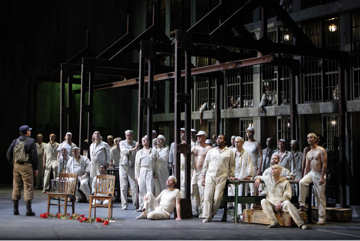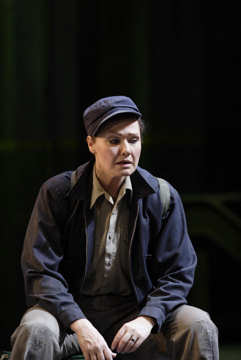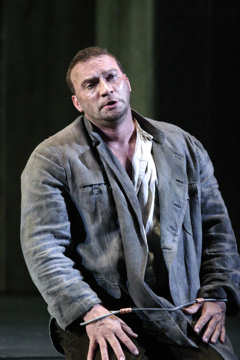|
|
|

Editorial
Board
London Editor:
(London UK)
Melanie
Eskenazi
Regional Editor:
(UK regions and Worldwide)
Bill
Kenny
Webmaster:
Bill
Kenny
Music Web Webmaster:
Len
Mullenger



|
MusicWeb is a
subscription-free site
Clicking Google adverts on our pages helps us keep it that way
Seen
and Heard Opera Review
Beethoven,
Fidelio:
Soloists, Orchestra and Chorus of the
Royal Opera House, Covent Garden, cond.
Antonio Pappano. 30.5.2007 (ME)

Karita Mattila is the most emotionally
involving and vocally convincing
Leonore I have heard in a long while,
and her Florestan, the massive German
tenor Endrik Wottrich is almost her
vocal equal, despite the way in which
the production seems to sideline his
character. This is a ‘new to The Royal
Opera House’ staging, imported from
the Met, and whilst it contains many
absurdities it also offers a mostly
straightforward, sympathetic reading
of Beethoven’s hymn to married love.
Mattila’s character actually manages
to look like a fanciable teenage boy,
and she plays his awkwardness and
insecurity for all they’re worth: to
me, her voice is perfect for the role,
almost ‘cello-like in the great Act 1
quartet, achingly tender in ‘Komm, O
Hoffnung’ and capable of startling
volume when required: her phrasing is
at once musical and individual, but
always apt. Wottrich was making his
house debut, and he is definitely a
singer I want to hear in Wagner – this
is a potentially great voice, with
plenty of heft as well as sweetness
when required, and he gave a superb
account of his aria. Sadly, the
director seemed to have decreed that
Florestan is a cipher who needs to be
hidden behind foggy lighting and lost
in a crowd.

Karita Mattila as Leonore
There were three other very strong
performances - Robert Lloyd’s noble,
troubled Don Fernando, Eric
Halfvarson’s reliable Rocco, and
Robert Murray’s strongly characterized
Jacquino. The Norwegian baritone Terje
Stensvold could pass for Fischer-Dieskau
at a distance, such is his powerful
physical presence, but alas the
resemblance ends there, since his
singing is under-powered and his
characterization rather sketchy. As
for Ailish Tynan’s Marzelline, the
Royal Opera House simply has no
business in fielding a singer with
such poor grasp of the language in
which the work is being sung: perhaps
we are meant to find an Irish accent
endearing, but her mangling of the
dialogue was just too much, though her
actual singing was musical enough.

Endrik Wottrich as Florestan
I liked the grim, vast prison set and
its contrast with the little home, and
especially the deep, deep dungeon with
its sense of utter separateness from
the world, and although there was a
lot of the
‘some-vague-South-American-dictatorship’
about proceedings in general, it
wasn’t too intrusive. However, there
is so much more to Fidelio than
we saw here: why, for example, are the
prisoners all dressed in pristine
white jump suits? (Try new! Wonder!
Florestan, with biological
brighteners!) and why do they hardly
appear to react at all to what’s going
on around them? Why is so little made
of the dialogue between Leonore and
Rocco as they prepare to dig the
grave?
(‘der Mensch hat so eine stimme..Ja,
sie drängt in die Teife des Herzens’
sounded more like ‘Nice hunky
guy…yeah, great butt.’) Why
do the women of the chorus in the
final scene (inexplicably got up like
leftovers from the ENO’s recent
‘Gondoliers’) appear not to be
remotely concerned about their freed
beloveds? Most of all, why are
Leonore and Florestan thirty feet
apart as they sing ‘O namenlose Freude’
so that ‘Mein Mann an meiner Brust’
actually caused some laughter?
Orchestrally, things got off to a
muted start, with some disparity
between stage and pit, but after the
prisoners’ scene a more confident
Pappano seemed to emerge, and there
was some very fine ensemble in the
second act. A mixed response, then,
but since any Fidelio stands or
falls on its ‘heroes,’ you won’t be
too disappointed.
Melanie Eskenazi
Pictures
©
Catherine Ashmore 2007
Back
to the Top
Back to the Index Page
|
Seen and Heard, one of the longest established live
music review web sites on the Internet, publishes original reviews
of recitals, concerts and opera performances from the UK and internationally.
We update often, and sometimes daily, to bring you fast reviews,
each of which offers a breadth of knowledge and attention to performance
detail that is sometimes difficult for readers to find elsewhere.
Seen and Heard
publishes interviews with musicians, musicologists and directors
which feature both established artists and lesser known performers.
We also feature articles on the classical music industry and we
use other arts media to connect between music and culture in its
widest terms.
Seen and Heard
aims to present the best in new criticism from writers with a radical
viewpoint and welcomes contributions from all nations. If you would
like to find out more email Regional
Editor Bill Kenny. |
|
| |
|
Contributors: Marc
Bridle, Martin Anderson, Patrick Burnson, Frank Cadenhead, Colin
Clarke, Paul Conway, Geoff Diggines, Sarah Dunlop, Evan Dickerson
Melanie Eskenazi (London Editor) Robert J Farr, Abigail Frymann,
Göran Forsling, Simon Hewitt-Jones, Bruce Hodges,Tim Hodgkinson,
Martin Hoyle, Bernard Jacobson, Tristan Jakob-Hoff, Ben Killeen,
Bill Kenny (Regional Editor), Ian Lace, John Leeman, Sue Loder,Jean
Martin, Neil McGowan, Bettina Mara, Robin Mitchell-Boyask, Simon
Morgan, Aline Nassif, Anne Ozorio, Ian Pace, John Phillips,
Jim Pritchard, John Quinn, Peter Quantrill, Alex Russell, Paul
Serotsky, Harvey Steiman, Christopher Thomas, Raymond Walker, John Warnaby,
Hans-Theodor Wolhfahrt, Peter Grahame Woolf (Founder & Emeritus
Editor)
|
Site design: Bill Kenny
2004 |

